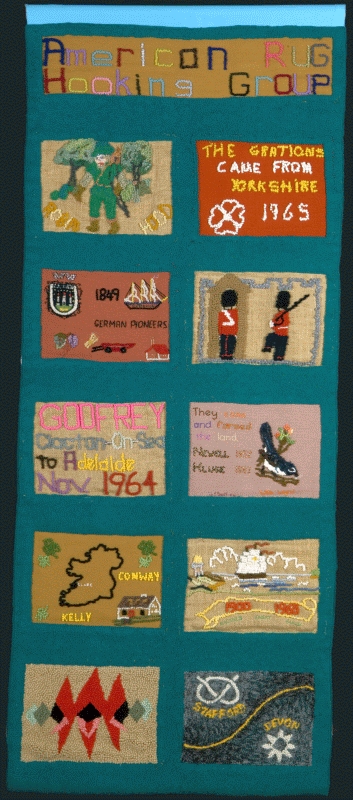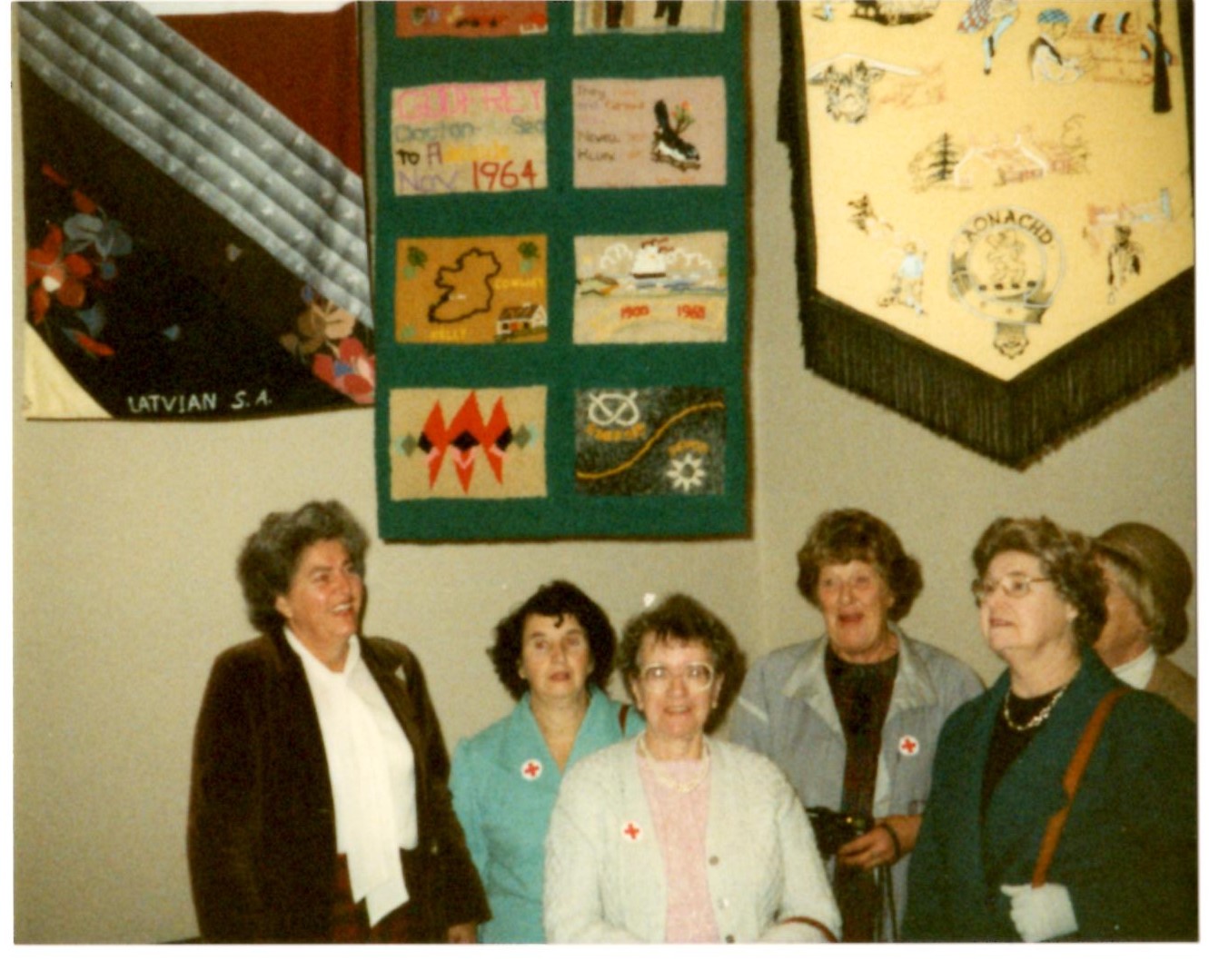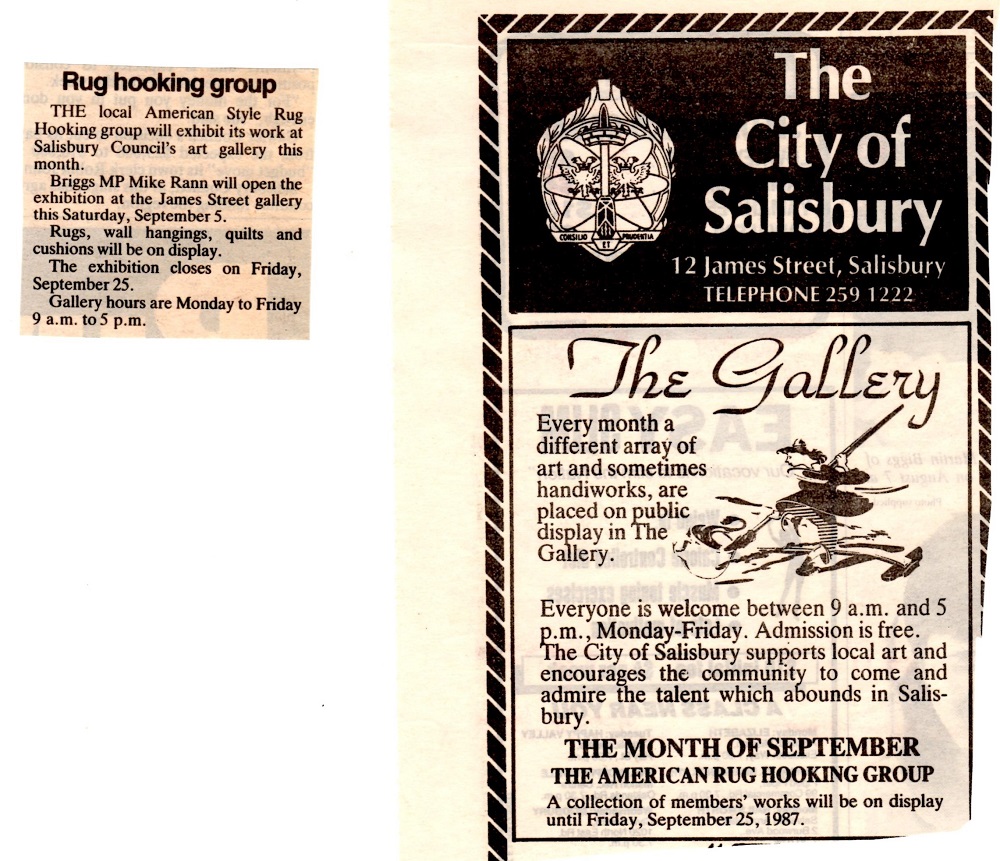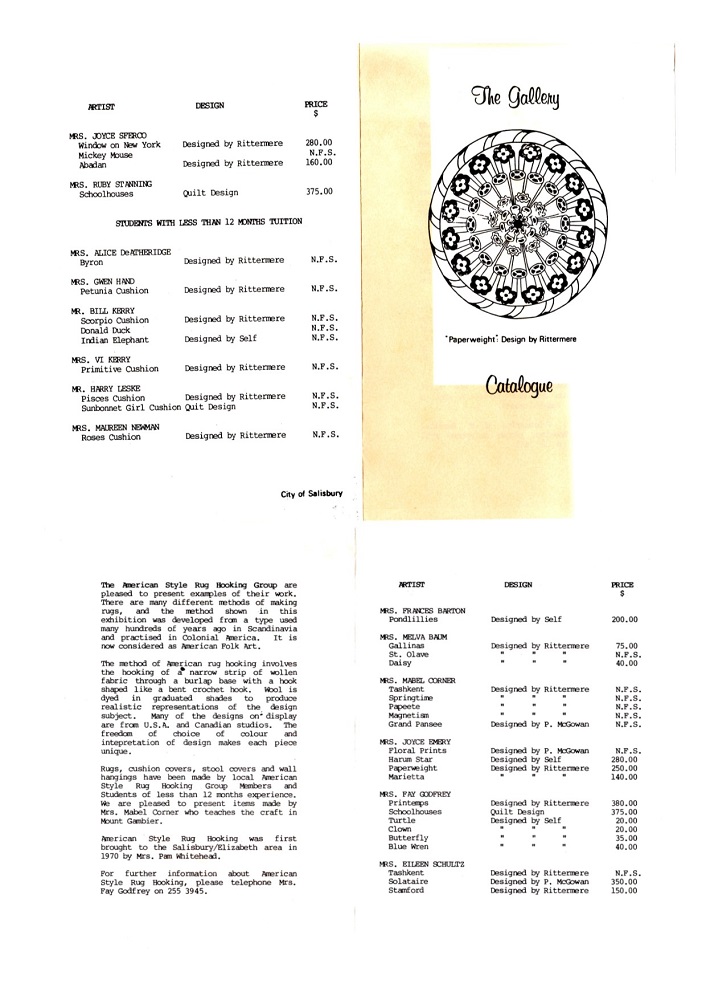From the Editor/Jo Franco
Because early hand hooked rugs were generally made from recycled clothing and not held in high regard, not many have survived and those that have are not documented. I’ve only come across a couple of locations where I’ve been able to view old hand hooked rugs although I’ve heard of several others – The Historic Homes in Sydney, various place in Tasmania and Glen Barr in South Australia.
Pioneer Women’s Hut, Tumbarumba, New South Wales:
In March 2010 on the way to visit the Narrawilly Proggers in Milton, NSW, Judith Stephens (ARG V.Pres) and I stopped to visit the Pioneer Women’s Hut in Tumbarumba, NSW. A bed rug (wagga) was on display, however the hooked rugs were stored in drawers. Several were SEMCO patterns and one was thought to be hooked by Margaret Preston – this same rug was pictured on page 43 of the 1990 article in Rug Hooking Magazine by Lee Pattinson.
These examples of rugs by Margaret Preston were shown on the Australian Art Auction Records website –
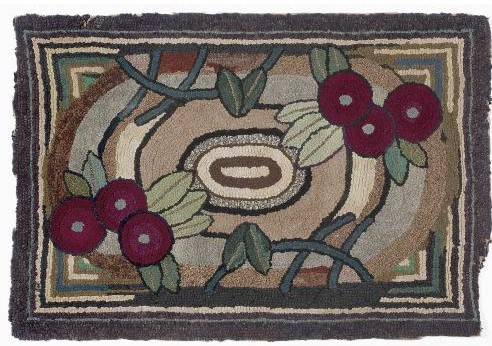

Powerhouse Museum, Sydney, New South Wales:
There are hooked rugs at the museum in the archives, not on exhibit, and prior arrangements must be made to view. Judith Stephens and I had planned to visit Sydney after the March 2010 Narrawilly workshops, so arrangements were made with Christina Sumner, Principal Curator Design & Society to inspect the archived rugs.
When Gene Shepherd(USA) who was giving workshops at Narrawilly heard about our proposed visit to the Powerhouse, he voiced an interest in joining us there. As it turned out, Diane Finnegan, at whose home he was staying in Sydney knew Christina Sumner – so the size of our viewing group expanded. There was much discussion as we studied a large number of rugs. Some appeared to be early “kits” however, several looked like originals made from recycled fabric which was of more interest to all of us. Diane took notes and I was given permission to take some “happy snaps” of Gene and Judy as we all studied the rugs. The images can be seen in the Apr/May/Jun 2010 issue of the Guild Newsletter.
Interestingly, an online search of the “Collections” on the Powerhouse Museum website turned up 10 rag rugs – however only a few with images. Read about these rugs on the link to “Collections”
Migration Museum, Adelaide: 8 Nov. 2016
These hooked rugs are in the archives of the Migration Museum, 82 Kintore Ave, Adelaide, South Australia 5001 (08) 8207 7570 – Open Daily 10am-5pm Mon-Fri and 1pm-5p Weekends – Admission is Free.
Many thanks to Corinne Ball, Curator – who retrieved the rugs from the archives to photograph and for her permission to show here.
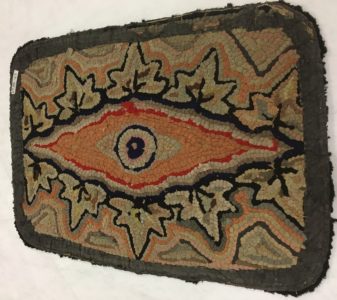
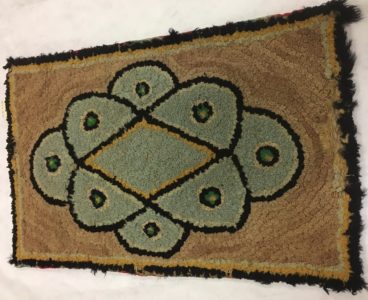
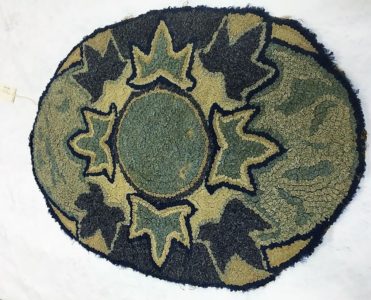
Image description : ‘Migration Museum collection HT86.404, donated by the American Rug Hooking Group’. http://migration.history.sa.gov.au/collections/community-banner-collection/three-traditions
The image (above) and following information was provided by the Corinne Ball, Curator of the Migration Museum, Adelaide, with permission to show on this page.
The 10 panel banner was created in 1986 as part of the museum’s Community Banners project, ‘Memories and Dreams’. Symbolic of cultural diversity in SA. Made by a rug hooking technique brought from America by Mrs. Pam Whitehead in 1969. Divided in 10 panels by a green border around each panel.
- Hooked by Connie Hopewell, depicts Robin Hood. She emigrated from Nottingham – Robin Hood country.
- Hooked by Connie Hopewell, depicts Robin Hood. She emigrated from Nottingham – Robin Hood country.
- Mrs. Nellie Grattan who came from Yorkshire symbolized by the white rose of York.
- Mrs. Eileen Schultz depicts family crest of Dahlenburg family who came in 1849, grapes, white, wagon and church all associated with German community.
- Mrs. Ruby Stanning who came from Britain. The guardsman represents her English heritage.
- Faye Godfrey, reads Clacton on Sea to Adelaide Nov. 1969. Mrs Godfrey features family surnames, Newell, Mrs. Godfrey’s mother’s family who arrived in 1852. Kluge her father who arrived in 1883. Features a willy-wagtail, relates to her early memories of farm life.
- Mrs. Joyce Sferco – map of Ireland with Irish cottage and shamrock family names of Kelly and Conway.
- Mrs. Joyce Emery, ship with maiden name and Mackness who came in 1900.
- Mrs. Francis Barton, sturt pea for her adopted country.
- Mrs. Jean Wills, Staffordshire knot for her family, Devon stone for her husband. Banner finished with turquoise gusset and lined in same and white.
Ten separate panels each represent a different migrant heritage. Three cultural traditions are highlighted: English, Irish and German. Symbols associated with the old country combine with details of the immigrants journey and images of life in the new land. While this banner reflects the individual experiences of the people involved, there is an essential unity in the use of a craft, i.e. an American folk tradition, dating from colonial times.
The image below was supplied by Mrs Faye Godfrey with permission to publish.
Faye Godfrey, Group leader, said : “The Migration and Settlement Museum banner was made with each group member hooking a piece depicting their original ancestry on an even weave furnishing fabric which was combined with green hooked edgings through both layers on to burlap. We all enjoyed the special unveiling of the banners entered.
The rug hooking group was known as American Rug Hooking Group, as the method and construction of our rugs was that of North America. This was because Pam Whitehead learnt to teach using the Pearl McGown method and was an accredited Pearl McGown teacher. Pam lived in Toronto Canada for some years prior to coming to Australia, she was originally from Lancashire UK. The name mutated to just “Elizabeth Rug Hooking Group” as the general public thought we were Americans and not locals.
1986 – Fort Worth, Texas, USA –
From Faye Godfrey, South Australia; “The art gift for Fort Worth, Texas, was part of the South Australian Sesquicentenary (1986) of the state. The City of Salisbury is twinned with Fort Worth. They are on the same latitude north as Salisbury is in the south. The project began with one commission to Anthea Oxford for one of her water colour works depicting the Salisbury area. Our group was part of the Northern Adelaide Arts Guild and Anthea was an active member. Suddenly, there were offers of a variety of paintings and other works that ended with about 30 items and there was a fund-raising event to pay for the packing and transport to Texas.
 My piece was the only hooked hanging on blue burlap and it depicts the SA State map and our State Emblems and that is me holding it.
My piece was the only hooked hanging on blue burlap and it depicts the SA State map and our State Emblems and that is me holding it.
Anthea travelled to Texas for the official ceremony in Ft Worth and relayed to me the positive comments on my piece, especially the use of opal type beads embedded in the hooked opal. The collection is in the Ft. Worth Library and toured many areas of Texas.”
1980’s Lyndock Institute, Barossa Valley –
From Faye Godfrey; “Rugs were displayed by the Elizabeth Rug Group (formerly the American Rug Group) at the Lyndock Institute, which is managed by local volunteers and was a hired venue only”.
1987 Exhibition in Sailsbury, South Australia –
Faye Godfrey, South Australia; “Here is the Catalogue and newspaper notice of the event. Faye says they have photos of almost every exhibit in the Salisbury Gallery display. Students with less than 12 months experience were my class and they were thrilled to be part of this event.”




